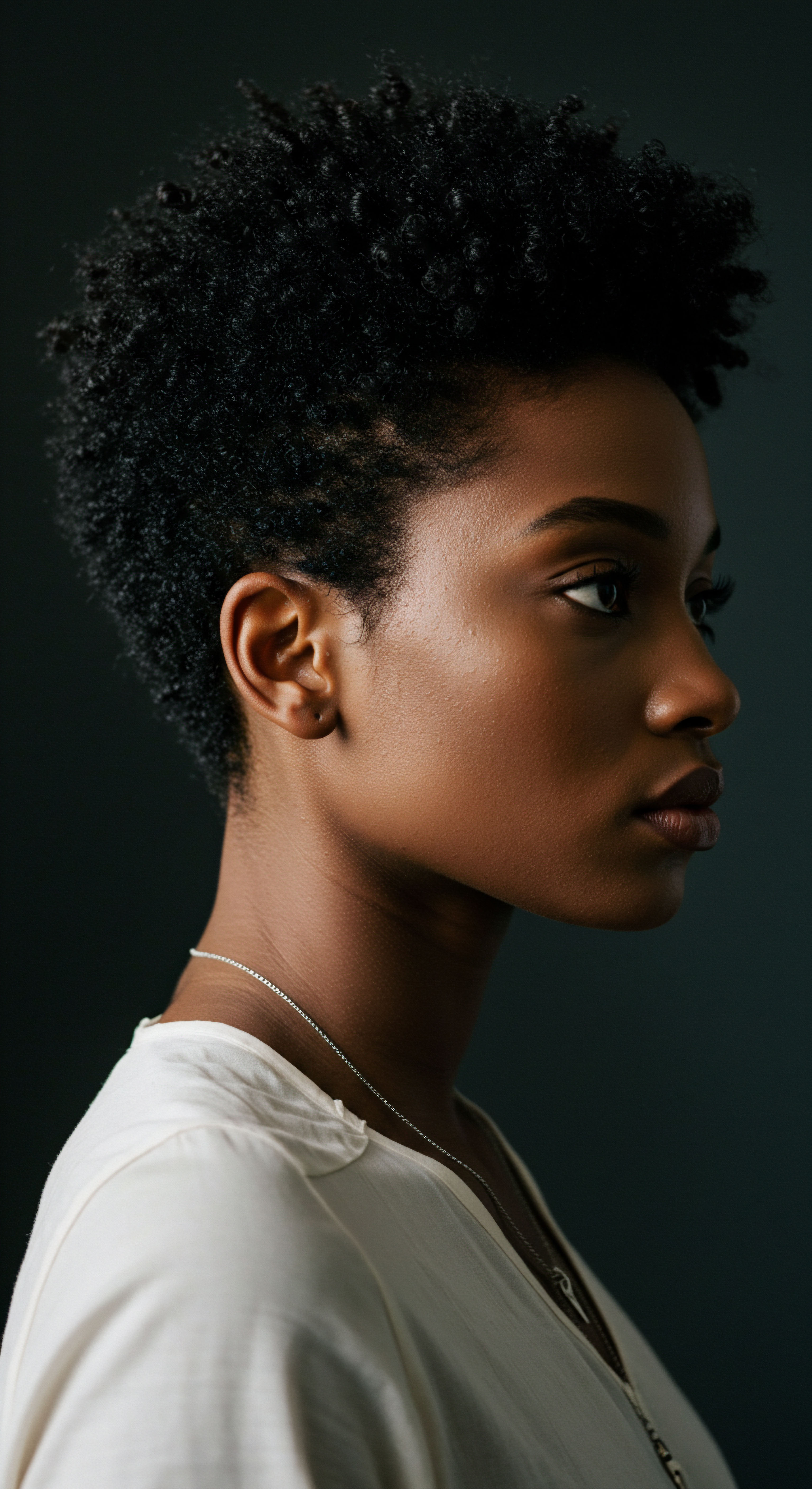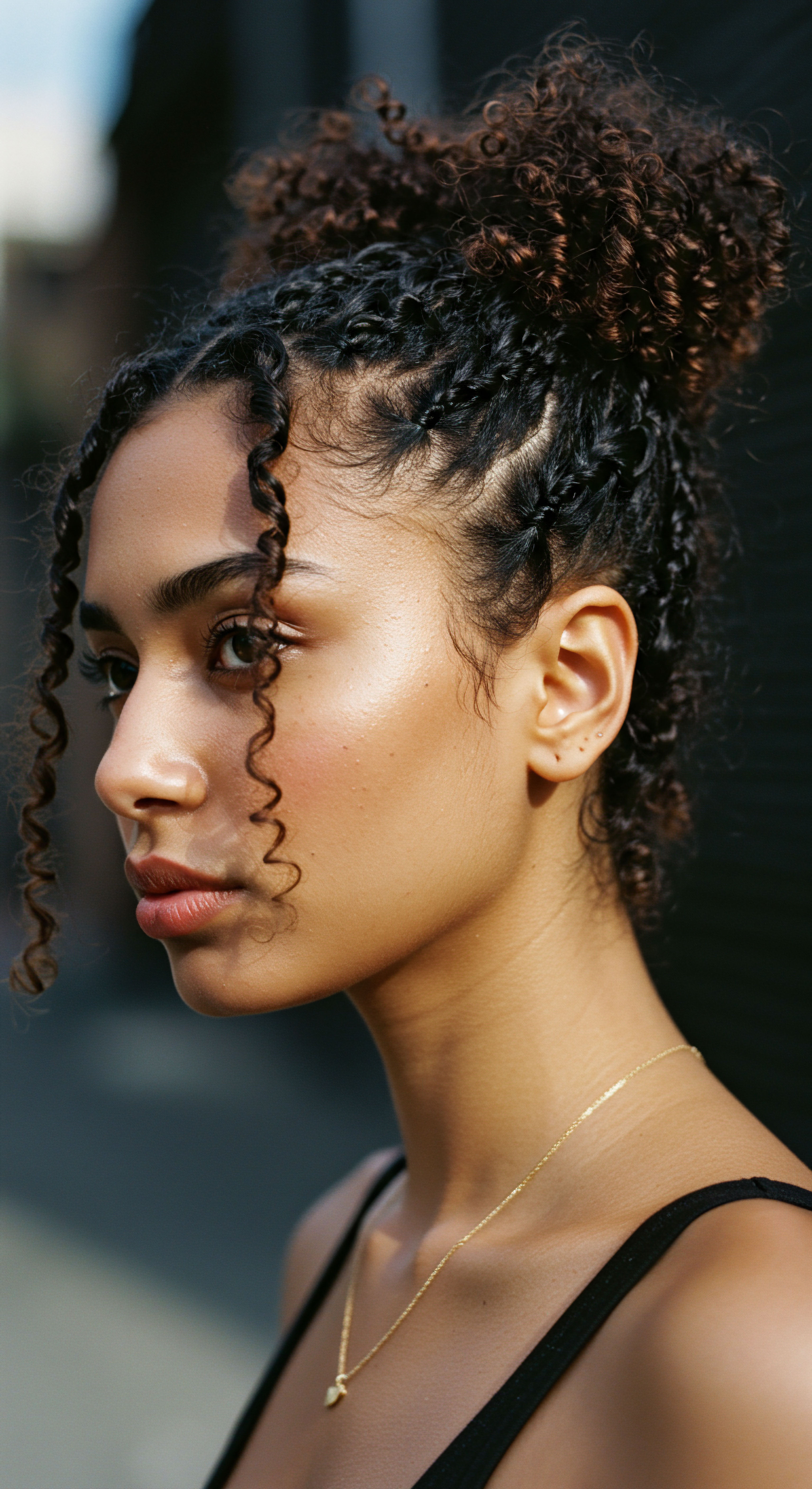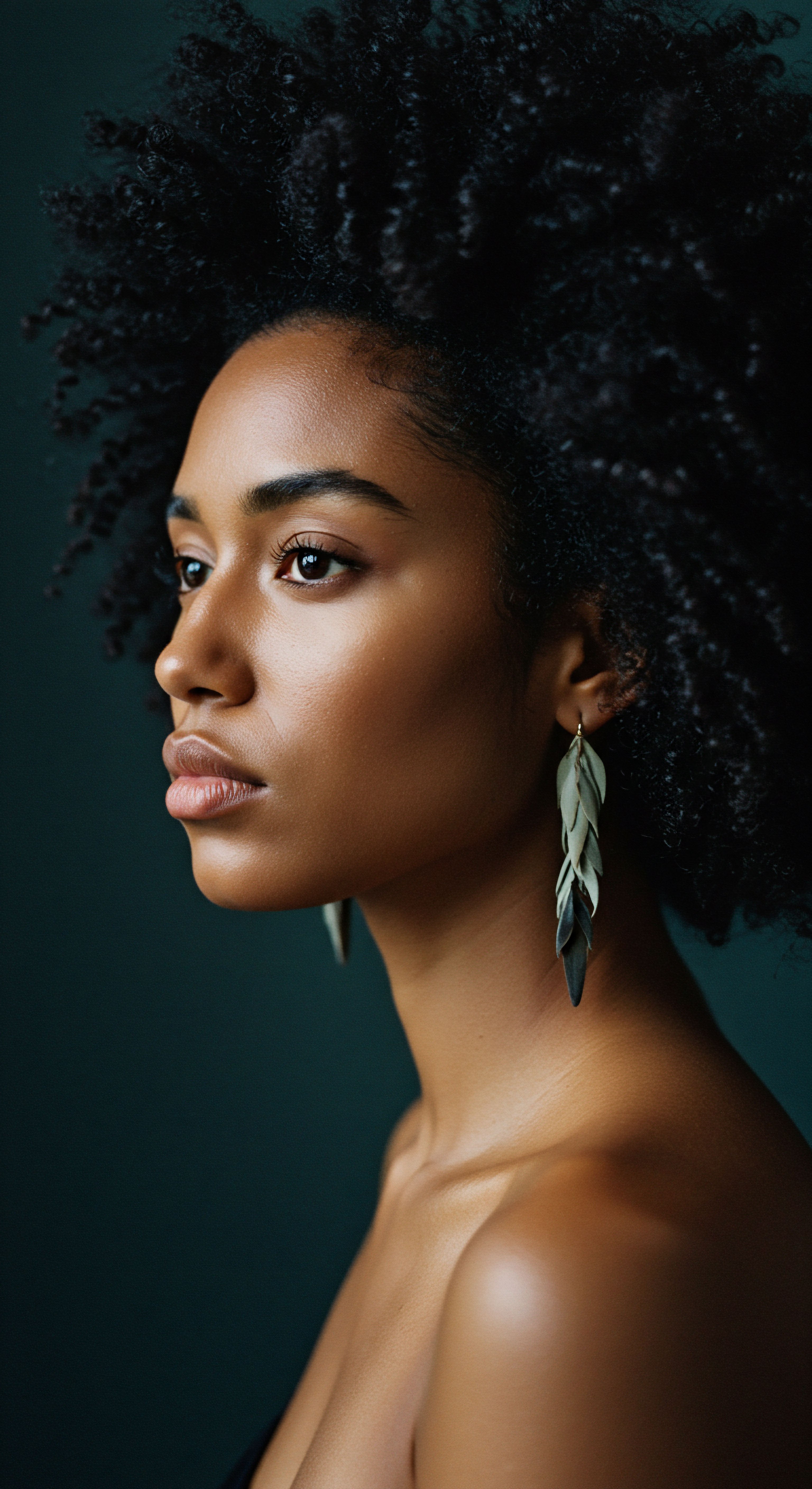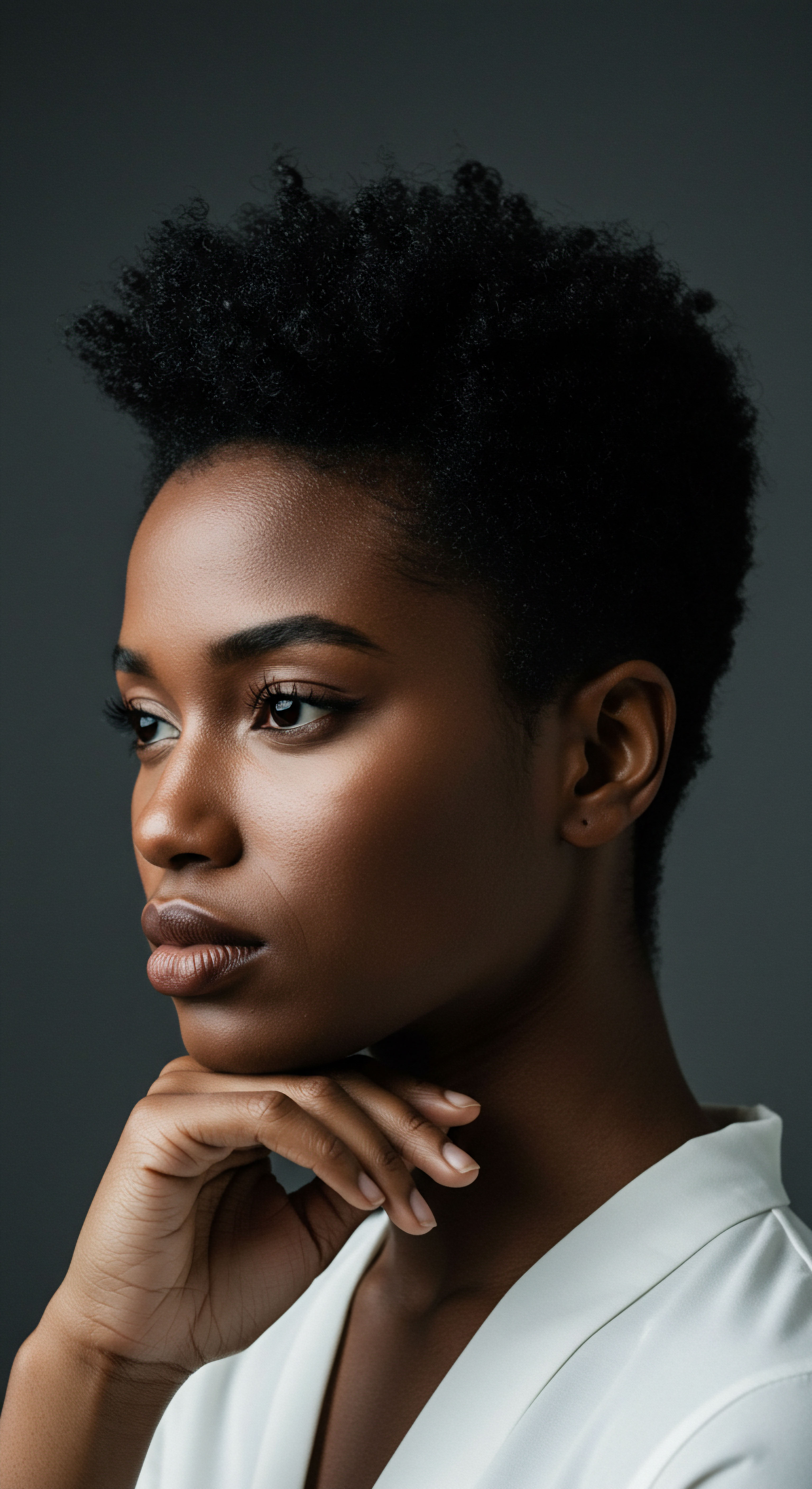
Roots
Consider for a moment the profound quietude of a single hair strand. Within its slender form resides an ancient story, a testament to nature’s precise design. It is more than a mere filament; it is a meticulously constructed marvel, each component playing its part in a symphony of strength and suppleness.
For textured hair, this inherent structure speaks volumes, carrying with it legacies of adaptation and resilience. Understanding this intrinsic architecture provides the grounding needed to truly comprehend how certain external forces, particularly chemical applications, can forever reshape its very being.
The foundation of hair’s enduring character lies in its primary constituent ❉ Keratin. This fibrous protein, a member of the intermediate filament family, comprises the vast majority of hair’s dry weight, typically ranging from 65% to 95%. Keratin proteins are not singular entities but rather long, helical chains of amino acids, forming complex networks.
These chains intertwine and coil, creating a resilient internal scaffolding that gives hair its shape, elasticity, and overall structural integrity. The inherent springiness of a curl, or the sleek flow of a straight strand, owes much to the way these keratin helices arrange themselves.

The Keratin Backbone
Deep within the hair’s cortex, the central, most substantial part of the strand, these keratin proteins align into highly organized macrofibrils and microfibrils. Imagine a bundle of tiny, strong ropes, each composed of even finer threads twisted together. This intricate organization contributes significantly to hair’s mechanical properties, allowing it to withstand stretching, bending, and the everyday stresses of life. The cortex, a veritable powerhouse, also houses melanin pigments, which bestow upon hair its remarkable spectrum of colors.

Disulfide Bonds The Hair’s Enduring Links
Central to hair’s stability and form are its Disulfide Bonds. These are robust chemical linkages formed between two cysteine amino acid residues, creating a stronger unit known as cystine. Picture these bonds as sturdy bridges connecting the long keratin protein chains. In curly or coily hair, these disulfide bonds are numerous and strategically placed, creating the distinct bends and spirals that define its natural texture.
In straight hair, while present, their arrangement allows for a more linear configuration. These bonds are remarkably durable, resisting disruption from water or mild physical manipulation, distinguishing them from weaker hydrogen and salt bonds. Their presence is paramount to hair’s enduring shape memory.
Hair’s inherent strength and shape are fundamentally defined by its keratin protein structure and the robust network of disulfide bonds.
Beyond the cortex lies the Cuticle, the hair’s outermost protective layer. Composed of overlapping, flattened cells, much like shingles on a roof, the cuticle acts as a shield, guarding the delicate inner cortex from environmental assaults and physical friction. A healthy cuticle lies flat, providing a smooth, reflective surface that gives hair its natural sheen and helps retain internal moisture. This layer is also adorned with a crucial lipid coating, the 18-methyl eicosanoic acid (18-MEA) layer, which contributes to hair’s hydrophobic (water-repelling) nature and its soft feel.

The Cuticle’s Guard
The integrity of this protective layer is paramount. When the cuticle is compromised, whether through mechanical wear or chemical interference, the hair becomes more vulnerable. It can lose its smooth appearance, feel rougher to the touch, and become more prone to tangling and breakage. The initial whispers of alteration often begin at this very surface, before deeper changes take hold within the protein core.
Understanding the interplay between the cuticle, cortex, keratin, and disulfide bonds is foundational. It provides the context for appreciating the delicate balance that maintains hair’s vitality and how deeply that balance can be affected when powerful chemical agents enter the scene. Each strand holds a history, and the way it responds to change is written within its very composition.
| Component Cuticle |
| Primary Composition Overlapping keratinized cells, 18-MEA lipid layer |
| Role in Hair Structure Outer protective barrier, manages moisture, provides sheen, reduces friction |
| Component Cortex |
| Primary Composition Keratin proteins, melanin pigments |
| Role in Hair Structure Main body of the hair, determines strength, elasticity, and color |
| Component Medulla |
| Primary Composition Disordered cells (not always present) |
| Role in Hair Structure Innermost core, can influence light absorption and hair color perception |
| Component Keratin |
| Primary Composition Fibrous protein (amino acids, especially cysteine) |
| Role in Hair Structure Primary building block, forms helical chains providing shape and resilience |
| Component Disulfide Bonds |
| Primary Composition Covalent links between cysteine residues |
| Role in Hair Structure Strongest bonds, stabilize keratin structure, responsible for hair's permanent shape |
| Component Each element contributes to the hair's overall health and responsiveness to its environment. |

Ritual
Stepping into the realm of chemical treatments is akin to participating in a deeply rooted practice, one that often carries generations of meaning and aspiration. For many, altering hair’s natural texture is a ritual of self-expression, a means of aligning outer appearance with an inner vision. Yet, beneath the surface of desired change lies a profound chemical transformation, a carefully orchestrated disruption of hair’s very core. To truly appreciate the art of these transformations, one must also grasp the science that governs them, recognizing how these processes reshape hair’s protein structures with lasting effect.
Chemical treatments fundamentally work by interacting with the hair’s protein bonds, primarily the resilient Disulfide Bonds. Unlike hydrogen and salt bonds, which are temporary and can be broken by water or changes in pH, disulfide bonds require stronger chemical intervention to alter. This is where the various treatment types diverge in their approach, each employing specific chemical agents to achieve their desired outcome.

Reshaping the Strand
Consider the process of hair relaxing or permanent straightening. These treatments aim to loosen or entirely straighten the hair’s natural curl pattern. They achieve this by introducing powerful alkaline solutions, often containing ingredients such as Sodium Hydroxide (known as lye relaxers) or Ammonium Thioglycolate. These chemicals act as reducing agents, effectively breaking the disulfide bonds within the hair’s keratin structure.
In the case of hydroxide relaxers, the process is particularly stark. They induce a reaction called Lanthionization, where a disulfide bond is cleaved, and one of the sulfur atoms is removed, creating a new, permanent lanthionine bond. This new bond is not a disulfide bond and cannot be reformed to its original state, making the alteration irreversible.
The hair’s natural curl pattern is thus permanently elongated, stretched into a straighter configuration. Thio relaxers, while also breaking disulfide bonds, utilize an oxidizing agent (like hydrogen peroxide) in a second step to reform new disulfide bonds in the hair’s straightened shape, though these too represent a permanent change from the original configuration.

The Alchemist’s Touch Coloring and Lightening
Hair coloring, especially permanent dyeing and bleaching, also significantly impacts hair’s protein structure. Bleaching, a process designed to lighten hair by oxidizing melanin pigments, is particularly aggressive. It relies on oxidizing agents, typically hydrogen peroxide, which not only strip color but also disrupt the disulfide bonds within the cortex. This disruption renders the hair’s cuticles more porous, allowing the chemical agents to penetrate deeply.
Permanent hair dyes similarly use alkaline solutions, such as ammonia, to swell and lift the cuticle layer, allowing dye molecules to enter the cortex. While the primary goal is color change, the oxidative reactions involved can cause collateral damage to the hair’s disulfide and peptide bonds, further weakening the internal structure. The frequent swelling of the cuticle can lead to permanent damage, making the hair more susceptible to external aggressors.
Chemical treatments intentionally disrupt hair’s internal protein bonds, fundamentally altering its structure and making these changes enduring.

When Bonds Break The Cost of Alteration
The consequence of these chemical interventions is a profound alteration of hair’s intrinsic mechanical properties. When disulfide bonds are broken, and the keratin structure is compromised, the hair’s Tensile Strength—its ability to resist stretching before breaking—is significantly reduced. Hair becomes weaker, more prone to breakage, and less resilient. This weakening is compounded by the loss of the protective 18-MEA layer and the increased porosity of the cuticle, which result from alkaline treatments and oxidation.
- Loss of 18-MEA Layer ❉ This outermost lipid layer, crucial for hydrophobicity and smoothness, is often removed by alkaline chemical treatments, leaving hair more hydrophilic and susceptible to swelling.
- Increased Porosity ❉ Damage to the cuticle creates openings, allowing more water to enter and exit the hair shaft, leading to dryness, frizz, and increased friction between strands.
- Reduced Elasticity ❉ The hair’s ability to return to its original shape after stretching is diminished, contributing to a limp, lifeless feel.
A study on the mechanical properties of damaged hair found that chemical treatments like dyeing, perming, and bleaching could cause mechanical damage, weakening hair fibers and making them break more easily. The study also highlighted that low-molecular-weight hyaluronate could improve the elastic modulus of overbleached hair, suggesting that while the damage is done, some measures can help restore certain properties. This underscores that while the original protein configuration is irreversibly changed, careful aftercare can mitigate some of the symptomatic damage.

Understanding Hair’s Changed Behavior
The hair, once chemically treated, exhibits a different behavior. It may feel drier, look duller, and be more susceptible to split ends. This is because the internal architecture, which provided its natural strength and moisture retention, has been fundamentally reconfigured. The permanent nature of these changes means that the altered sections of hair cannot biologically repair themselves, as hair cells are dead once they emerge from the follicle.
New growth will, of course, possess its original structure, creating a demarcation line that often necessitates continued treatment or a transition period. The ritual, then, becomes a continuous cycle, each application adding to the cumulative alteration of the hair shaft.

Relay
To truly comprehend the lasting touch of chemical treatments on hair, we must look beyond the immediate visual transformation and consider the deeper currents at play. What hidden burdens might these powerful alterations carry, extending beyond the visible strand to influence well-being in ways seldom discussed in beauty spaces? For textured hair, in particular, the choice to chemically alter one’s natural pattern is often steeped in a complex cultural narrative, one that intertwines personal aesthetics with societal expectations and historical pressures. This profound context invites us to explore the science of irreversible alteration not just at the molecular level, but also within the broader human experience.

Beyond the Strand Cultural Pressures
Across generations, particularly within Black communities, chemical hair straightening has been a pervasive practice, driven by a desire for versatility, ease of management, or to conform to dominant beauty standards. This cultural backdrop is critical to understanding the widespread adoption of these treatments. The pursuit of sleek, straight hair became, for many, a gateway to perceived professionalism or acceptance in various social spheres. This long-standing tradition, while offering personal choice, has also inadvertently exposed millions to chemicals that science is only now beginning to fully understand in terms of their long-term health implications.

The Unseen Burden Health Considerations
While the physical alteration of hair proteins—the breaking of disulfide bonds and the subsequent weakening of the keratin structure—is well-documented, a more concerning, yet often overlooked, aspect of chemical treatments lies in their potential systemic impact on the body. A growing body of research indicates a concerning link between the frequent and prolonged use of chemical hair relaxers and serious health issues, particularly among Black women who disproportionately use these products.
These health concerns extend far beyond the hair shaft itself. Studies have identified a range of chemicals in hair relaxers, including Phthalates, Parabens, Formaldehyde, and Sodium Hydroxide, many of which are classified as Endocrine-Disrupting Chemicals (EDCs). EDCs are substances that can interfere with the body’s hormonal system, potentially leading to a cascade of health problems.
Beyond cosmetic changes, certain chemical hair treatments carry potential systemic health risks, particularly from endocrine-disrupting chemicals.
One striking and often controversial data point comes from a 2022 study by the National Institute of Environmental Health Sciences (NIEHS), which examined over 33,000 racially diverse women aged 35 to 74 over more than a decade. The findings revealed that women who reported using hair straightening products four or more times a year had a significantly elevated risk of developing Uterine Cancer. Specifically, the rate of uterine cancer in this group was 4.05%, compared to 1.64% in those who did not use such products. This suggests a more than doubling of risk for frequent users.
The mechanism behind this link is thought to involve the absorption of EDCs through the scalp, especially when the scalp is irritated or burned by the strong chemicals, creating openings for easier entry into the bloodstream. Once absorbed, these chemicals can mimic or interfere with natural hormones, potentially contributing to the growth of hormone-sensitive cancers.

A Deeper Look at Endocrine Disruptors
The implications of EDCs in hair products are broad. Beyond uterine cancer, research has connected them to other adverse outcomes ❉
- Ovarian Cancer ❉ Some studies indicate a higher risk for ovarian cancer among users of hair straighteners.
- Uterine Fibroids ❉ These non-cancerous growths in the uterus have also been linked to chemical relaxer use.
- Early Menstruation ❉ Exposure to EDCs in hair products has been associated with earlier onset of puberty in girls.
- Respiratory Issues ❉ Fumes from treatments containing formaldehyde can cause breathing problems and long-term lung damage with frequent exposure.
This area of inquiry, while sensitive, demands our attention. The fact that many of these products have been heavily marketed to Black women for decades, often without full disclosure of potentially harmful ingredients due to regulatory loopholes, underscores a systemic issue. The consequences of chemical treatments extend beyond the visible texture of hair, touching upon the very foundations of health and well-being.
| Chemical Category Alkaline Agents |
| Common Examples Sodium Hydroxide (Lye), Ammonium Thioglycolate |
| Linked Health Concerns Scalp irritation, chemical burns, structural hair damage, hair loss, thinning |
| Chemical Category Endocrine-Disrupting Chemicals (EDCs) |
| Common Examples Phthalates, Parabens, Formaldehyde |
| Linked Health Concerns Uterine cancer, ovarian cancer, uterine fibroids, early menstruation, hormonal imbalances |
| Chemical Category Other Volatile Organic Compounds (VOCs) |
| Common Examples Various fumes released during application |
| Linked Health Concerns Respiratory issues, irritation of eyes and throat |
| Chemical Category Ongoing research continues to clarify the full scope of health implications. |

The Lasting Legacy of Alteration
The irreversibility of chemical alterations in hair protein structures speaks to the profound power of these treatments. Once the disulfide bonds are permanently broken or reformed in a new configuration, the hair’s natural blueprint is erased in those treated sections. This means that true “repair” of the original structure is not possible; instead, care focuses on managing the altered state and preventing further degradation. The damaged hair, being dead cells, cannot heal itself.
This enduring change in the hair’s physical properties, coupled with the emerging understanding of systemic health risks, invites a more thoughtful and informed approach to hair care practices, particularly those that have become ingrained rituals over time. It is a call to recognize the full story behind the smooth surface.

Reflection
As we draw our exploration to a close, a gentle understanding settles upon us. Hair, in its magnificent diversity, holds not only aesthetic beauty but also a deep scientific narrative. The story of chemical treatments and their lasting touch on protein structures reminds us that every choice we make for our strands carries a consequence, both seen and unseen.
It is a testament to the resilience of our hair, yet also a quiet plea for mindful care. May this knowledge serve as a compass, guiding us toward choices that honor the innate strength and vibrancy of our textured hair, recognizing its delicate balance and the wisdom held within its very fibers.

References
- Halal, John. Hair Structure and Chemistry Simplified. 5th ed. Milady, 2009.
- Robbins, Clarence R. Chemical and Physical Behavior of Human Hair. 5th ed. Springer, 2012.
- Dias, Maria Fernanda Reis Gavazzoni. “Hair Cosmetics ❉ An Overview.” International Journal of Trichology 7, no. 1 (2015) ❉ 2–15.
- Puzan, Mariia, et al. “On Hair Care Physicochemistry ❉ From Structure and Degradation to Novel Biobased Conditioning Agents.” Polymers 15, no. 3 (2023) ❉ 608.
- Yu, Yang. “Structural and Mechanical Properties of Alpha-Keratin Fibers.” PhD diss. University of California, San Diego, 2012.
- Lyu, Jinfeng, et al. “Improving the Mechanical Properties of Damaged Hair Using Low-Molecular Weight Hyaluronate.” Molecules 27, no. 22 (2022) ❉ 7701.
- Sanad, Rania M. et al. “Effects of Chemical Straighteners on the Hair Shaft and Scalp.” Journal of Cosmetic Dermatology 18, no. 4 (2019) ❉ 929-935.
- Wise, L. A. et al. “Hair relaxer use and risk of uterine leiomyomata in the Black Women’s Health Study.” American Journal of Epidemiology 175, no. 5 (2012) ❉ 432-440.
- Chang, Chia-Jung, et al. “Hair product use and risk of uterine fibroids in the Black Women’s Health Study.” Environmental Health Perspectives 127, no. 6 (2019) ❉ 067004.
- White, Adana A. et al. “Hair dye and chemical straightener use and breast cancer risk in the Black Women’s Health Study.” Carcinogenesis 42, no. 2 (2021) ❉ 263-271.
- Keegan, Thomas H. et al. “Hair product use and ovarian cancer risk in the Black Women’s Health Study.” Cancer Epidemiology, Biomarkers & Prevention 30, no. 8 (2021) ❉ 1528-1535.
- Cheatham, T. W. et al. “A Comparative Study on Mechanical Properties of Treated and Untreated Animal Fibers Reinforced Unsaturated Polyester Resin Composites.” Journal of Polymer and Composites 9, no. 2 (2021) ❉ 112-120.
- Kaur, H. et al. “Chemical Hair Relaxers Have Adverse Effects a Myth or Reality.” International Journal of Trichology 5, no. 1 (2013) ❉ 26-29.